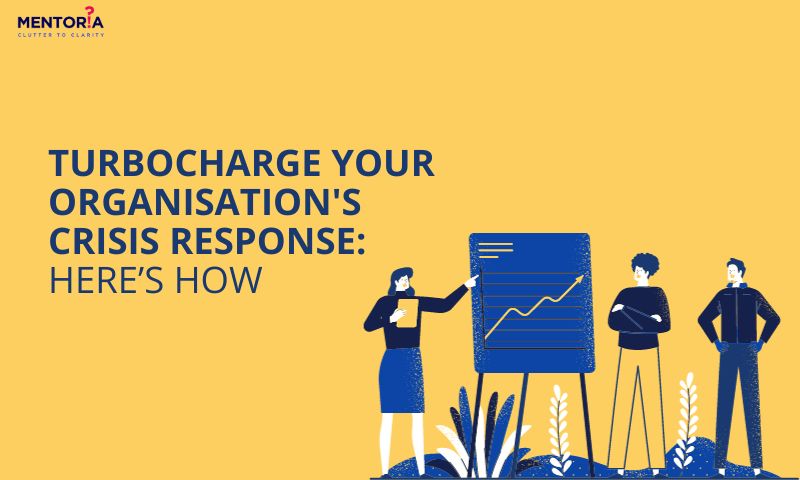Turbocharge Your Organisation’s Crisis Response

We’ve all been there – that heart-pounding moment when a crisis hits, and you’re left wondering, “Now what?” In a world where change and disruption are as common as your morning cup of coffee, organisations can’t afford to hit the snooze button when it comes to crisis response. It’s time to level up and discover how to not just weather the storm, but surf the waves like a pro. In this blog, we’re going to dive deep into the art of 10xing your crisis response and adapting to disruption faster than you can say “emergency meeting”.
Riding The Waves Of Chaos
The Art Of Crisis Response: Beyond Reaction
The first step in supercharging your crisis response is to understand that it’s not merely about reacting when something goes wrong. It’s about having a proactive approach to anticipate, prepare, and mitigate potential disasters. Here’s how to do it:
- Scenario Planning: Imagine a world where you foresee potential crises before they happen. That’s the essence of scenario planning. Think of it as rehearsing for a play where you know all the possible plot twists. It enables you to be well-prepared and respond swiftly when the unexpected occurs.
- Cross-Functional Teams: Assemble a diverse team from various departments within your organisation. Their different perspectives can help in identifying potential risks and devising innovative solutions.
- Root Cause Analysis: After a crisis, don’t just stop at solving the immediate issue. Dig deep into the root causes to prevent it from happening again. It’s like fixing a leaky roof instead of placing buckets all over your house.
Flexibility: The Secret Sauce Of Adaptability
Adaptability is the magic wand that can turn any crisis into an opportunity. To adapt faster, organisations should embrace these strategies:
- Agile Methodology: Many software developers are familiar with Agile, but its principles can be applied across various sectors. It’s all about incremental progress, continuous feedback, and the ability to pivot when necessary. Be like a river, not a stagnant pond.
- Open Feedback Culture: Encourage open and honest feedback from employees at all levels. Sometimes, the best insights come from those who are in the trenches, experiencing daily challenges. Your team can be your biggest source of innovation.
- Learn from Nature: Nature has been adapting for billions of years. Take inspiration from it. Study how ecosystems evolve, how species adapt to changing environments, and apply those principles to your organisation.
Data-Driven Decision Making: The Crystal Ball Of The Modern Era
Data is not just a buzzword; it’s a game-changer. By harnessing the power of data-driven decision-making, organisations can foresee storms on the horizon and navigate through them effectively.
- Predictive Analytics: Use historical data to predict future events. If you know that certain patterns precede a crisis, you can take preventive measures.
- Real-time Monitoring: In the digital age, real-time data is invaluable. Monitor social media, news, and industry trends. It’s like having a radar for potential issues.
- Machine Learning: If you’re dealing with vast amounts of data, consider implementing machine learning algorithms. They can spot anomalies and patterns that humans might overlook.
Embracing Innovation And Technology
Technology is evolving at the speed of light. Organisations that want to 10x their crisis response must be at the forefront of innovation. Here’s how:
- Internet of Things (IoT): IoT devices can monitor everything from the condition of machinery to environmental factors. This real-time data can alert you to potential issues before they become critical.
- Blockchain: This technology is not just for cryptocurrencies. It can be used to create transparent and tamper-proof supply chains, making it easier to identify and solve problems.
- Artificial Intelligence (AI): AI can analyse massive amounts of data, detect anomalies, and even suggest solutions. It’s like having a brilliant analyst working 24/7.
Cultivate A Culture Of Resilience
Your organisation’s culture plays a pivotal role in how it responds to crises. Resilience should be embedded in your DNA. Here’s how to nurture it:
- Leadership at All Levels: Encourage everyone in your organisation to be a leader in their own right. When individuals take responsibility and initiative, it creates a robust support system.
- Mental Health Support: A crisis can take a toll on the mental health of your team. Make sure you provide resources and support to help them cope and recover.
- Continuous Learning: Keep the spirit of learning alive. Encourage your employees to adapt and grow, both personally and professionally.
Learn From The Best: Case Studies In Crisis Response
Let’s dive into some real-world examples of organisations that have mastered the art of crisis response:
- Johnson & Johnson’s Tylenol Crisis: In the 1980s, when cyanide-laced Tylenol capsules hit the market, Johnson & Johnson acted swiftly. They recalled 31 million bottles, redesigned packaging, and implemented tamper-evident seals, setting a benchmark for crisis management.
- Domino’s Pizza Turnaround: When a video showing employees mishandling food went viral, Domino’s didn’t just apologise. They overhauled their entire operation, from product quality to delivery. Today, they are a prime example of a brand that came back stronger after a crisis.
- Toyota’s Brake Recall: When Toyota faced a massive recall of millions of vehicles due to brake issues, they didn’t downplay it. Instead, they apologised, fixed the problem, and improved their quality control. They emerged with a stronger reputation for safety.
Navigating Disruption With Mentoria
Embracing an agile approach to crisis response and adaptation is the key to staying ahead in today’s dynamic world. Organisations that adopt these strategies will not only weather the storm but emerge stronger and more resilient. Mentoria stands as your strategic partner in this journey, offering expert guidance and support. With Mentoria, you can accelerate your crisis response capabilities and navigate disruptions with confidence. Together, we’ll shape a future where challenges become opportunities for growth.









